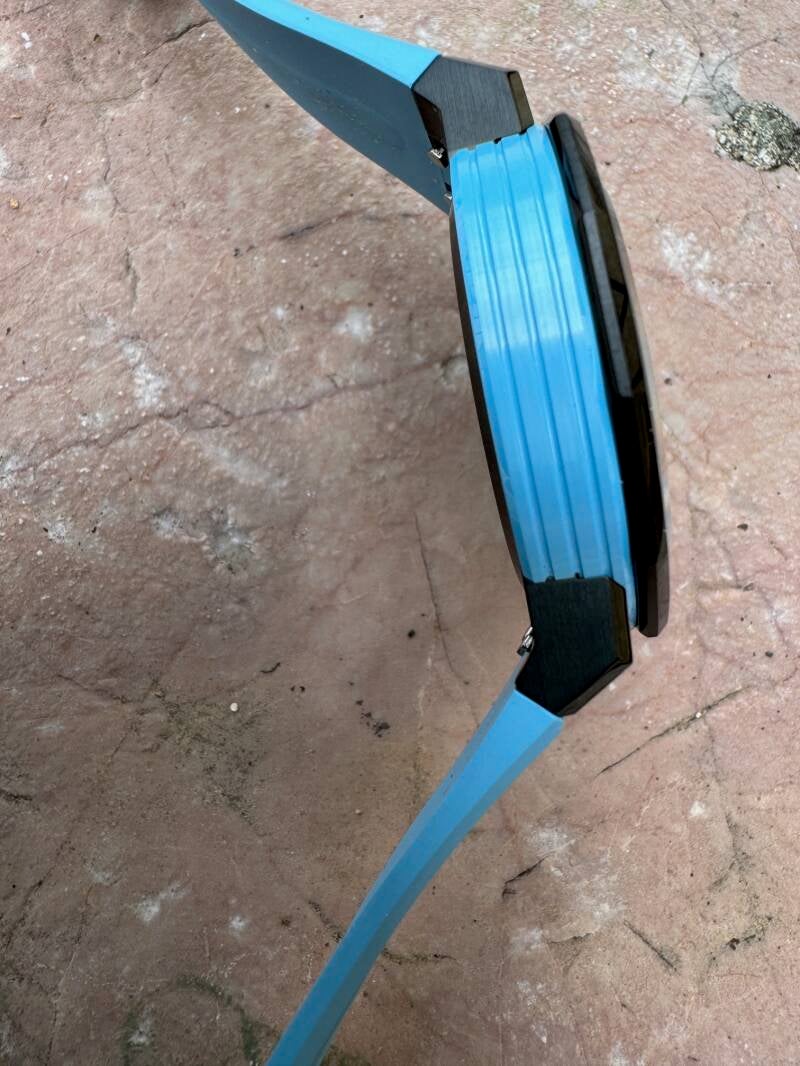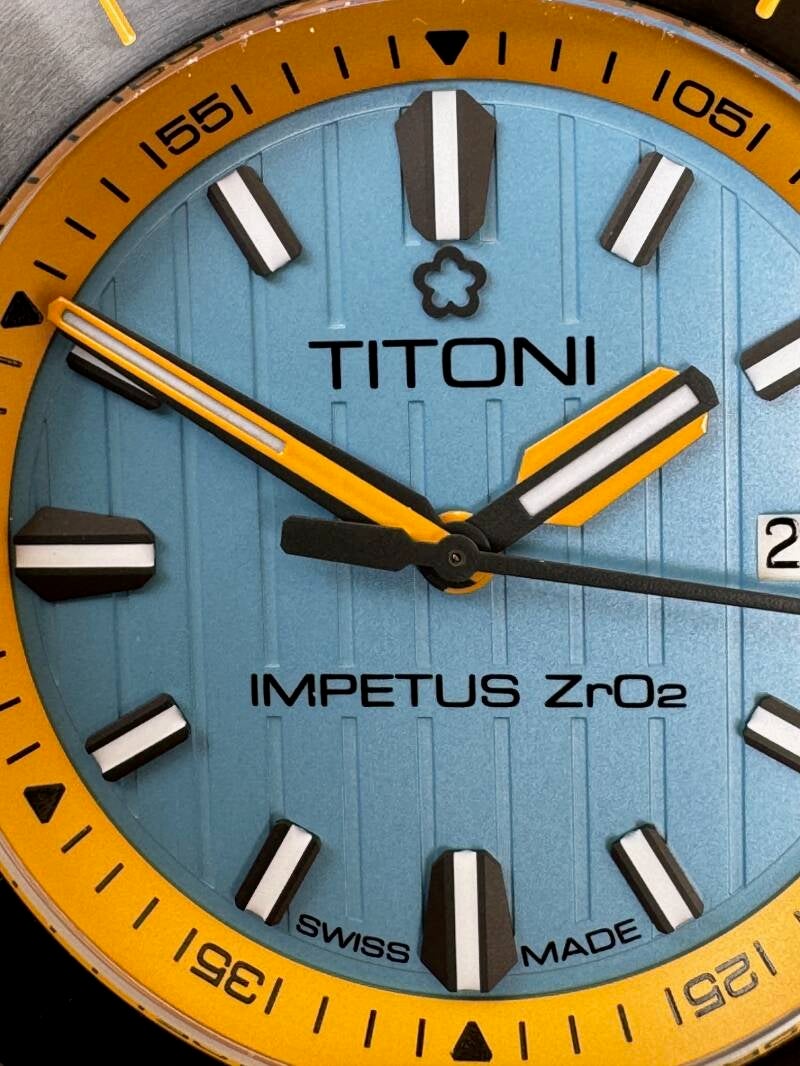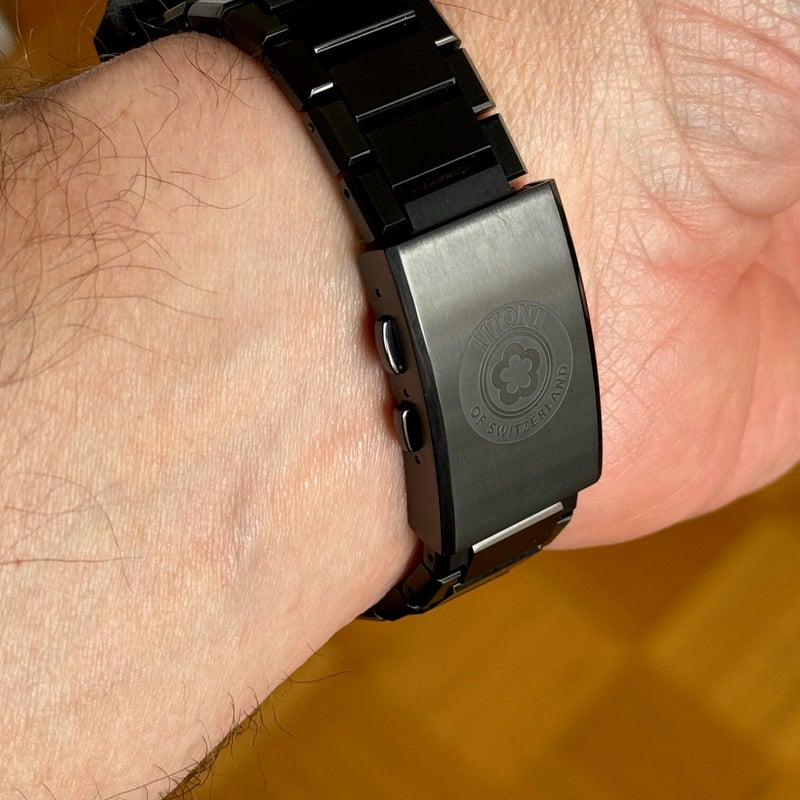

Today, I’m focusing on a watch that I purchased completely unplanned—in fact, one look was enough. How did this happen? Well, I was browsing my notepad on Chrono24 (a kind of wish list), and while checking out one of the watches on my list, Chrono24 suggested something interesting at the bottom of the page under the category “You may also be interested in these watches.” There it was: the Titoni Impetus CeramTech in the Argentine Blue version. The moment I saw it, I was excited—the combination of color and materials was just insanely good. “I must have this watch,” was my only thought.
I must admit—somewhat embarrassingly—that I had never heard of the Titoni brand before. I assumed it was just another microbrand, as new ones seem to pop up around the world every day. So you can imagine my surprise when I found out that Titoni is actually an old, independent, family-owned company, established all the way back in 1919. In fact, the brand name “Titoni” was only introduced in 1952; before that, the company was known as Felca—a name I was familiar with.
While learning about the brand, I also checked to see if there might be another watch in their collection that could be even more interesting. The Impetus model actually comes in several other color combinations, but all the others felt much more “common” and dull compared to the Atlantic Blue version. Another tempting option would have been one of the Seascoper carbon/ceramic diver models with their in-house chronometer movement (called the T10), but in the end, the Impetus won.
So, what makes this Impetus Atlantic Blue watch so special? First of all, the color combination is unlike anything I’ve seen before. A light blue dial with a yellow inner chapter ring, a case combining black and light blue, and a black bezel again featuring yellow markings. On top of that, the hands are also yellow. Even the crown is fully coordinated, featuring all three main colors—black, yellow, and light blue. And that’s not all. The rubber strap perfectly matches the case, in the same light blue tone, paired with a black buckle. Since the watch also comes with a bracelet, that too follows the theme, entirely in black to match the other components.
The second unique feature is the material used—or, more precisely, zirconium oxide. According to CeramTec Industrial: “Unlike other ceramic materials, zirconium oxide (ZrO₂ – also known as zirconia) is a material with very high resistance to crack propagation. Zirconium oxide ceramics also have very high thermal expansion and are therefore often the material of choice for joining ceramic and steel.” And this is exactly what Titoni has done here. The stainless steel case (DLC-coated) is paired with a zirconium oxide ceramic exoskeleton (including the crown cap), which allows Titoni to experiment with colors as well. If zirconium oxide really does offer such excellent resistance properties, then this combination is a definite win-win. I didn’t try to scratch the case on purpose, of course, but so far I haven’t noticed any—no matter how small. And I’ve already used the watch during some rather heavy-duty handwork (with the rubber strap, to be precise).
I also tried to figure out how the zirconia parts are “fused” to the steel case. I’m no expert, so once again I’ll refer to CeramTec’s explanation: “…very high thermal expansion and are therefore ... the choice for joining ceramic and steel.” That might be the key to how the case is constructed. Whether a crack might occur between the two materials—and under what conditions—only time will tell.
Since pictures say more than a thousand words, take a look at the ones below.













I need to say a few separate words about the dial, because everything on it is executed just perfectly. The base color is in perfect harmony with the case, and the straight lines on the dial echo the shape of the case. The hour indexes are exceptionally well designed, with the four main indexes shaped to match the hour hand. The only thing that slightly bothers me is the TITONI text, which is, in my opinion, too large—especially considering that the logo is already present. The font size used for IMPETUS ZrO₂ would have been more than sufficient for TITONI as well. That said, I quite like the zirconia reference on the dial; after all, this is the most unique and defining feature of the watch.
I already mentioned the hands, which I have absolutely no complaints about. They are well-made, highly functional, and easy to read. The black and yellow combination gives them a fresh and distinctive look. The date window might be a bit too small, but overall, the date is still easy to read.
The dial is neatly framed by a chapter ring.
Now to the only real disappointment of the watch—the bezel. It is fixed and serves only as a decorative element, marking five-minute intervals. If you look closely, the bezel and chapter ring alternate in five-minute markings, either with numbers or simple indexes. For example, "05" appears on the chapter ring, followed by "10" on the bezel, then "15" on the chapter ring, and so on. And that’s it. My issue with the bezel is that it doesn’t offer any real function beyond decoration. It’s a nicely dodecagon-shaped bezel made of brushed DLC-coated steel—which basically invites scratches.
So here we have a 300m water-resistant watch, designed in a diver style, but without any practical use beyond telling the time. (And if I may be a bit sarcastic—even that’s debatable, since there are no hour markers, only minutes!) Of course, the logical question is how many people who actually dive still use mechanical watches with a rotating bezel, so perhaps a functional bezel isn’t even needed. Still, I can’t help but feel disappointed.
I’ve already mentioned some of the technical specifications, but let me now summarize them all. The watch features a sapphire crystal with anti-reflective coating on both sides, and the caseback is also made of sapphire. The diameter is 43 mm, the height just 12 mm, and the lug-to-lug distance is 50 mm. So don’t worry—even though the diameter is 43 mm, the watch doesn’t appear overly large on the wrist. Just check my wrist shots with both the rubber strap and the bracelet.
Notice how the rubber strap gives the watch a completely different character compared to the bracelet. I was absolutely sure that my personal choice would be the rubber version—but now, I’m not so sure anymore.


At first, I didn’t even want to resize the bracelet to fit my wrist, since the rubber strap looked so good and felt so soft. I was also a bit hesitant because of the DLC-coated bracelet—scratches could easily become an issue here. But since the watch comes with quick-release lugs, I attached the full-size bracelet just for comparison. I was immediately impressed by how good it looked, and the very next step was, of course, to size the bracelet for my wrist.
The bracelet’s clasp includes a four-step extension, which allows for a very precise fit. Plus, the links can be easily removed using push-pins that can be knocked out from either side, making bracelet adjustment a simple task.
The clasp is engraved with a large Titoni logo. Additionally, there are two movable Titoni-branded rubber rings—one on each side of the bracelet—which add a unique and playful detail.




I’m not entirely sure what the purpose of those two rubber bands on the bracelet is, or whether they’re even intended to be worn together with the bracelet. As you can see in the wrist shots—I did wear them. At first, it seemed like a fun detail, maybe even a good joke. But after some time, I found them a bit annoying, constantly sliding around. So, for now, I’ve removed them from the bracelet.
I also have to compliment the lume. It’s very bright, long-lasting, and only the necessary elements are illuminated—just the way I like it.
In all my enthusiasm about the watch’s design, I almost forgot to mention the movement. Here, Titoni went with a rather unusual choice: the ETA 2892-A2. So, no standard 2824 or Sellita SW200 (which is used in some of their other models), and unfortunately, not even their in-house flagship T10 movement. A pity—this almost made me go for the Seascoper instead of the Impetus. Still, the 2892 is a fine movement. In my watch, the initial performance was around –5 seconds per day. Titoni gold-plated the rotor, which adds a nice touch and gives the movement an overall high-grade appearance.
What’s a bit confusing, though, is the packaging. The watch does not meet COSC chronometer specifications, and yet the box includes a COSC certificate and an extended warranty card—for T10 and chronometer movements. In this case, both the certificate and the card are essentially blank and irrelevant. The only plausible explanation is that Titoni uses the same packaging for all of their watches, and simply fills out the documents for those that are chronometer-certified.
Still, despite that excuse, I find this approach misleading. In my opinion, Titoni made a big mistake by not equipping this watch with their in-house movement—or at the very least, with a certified COSC-grade movement.



The original price for this version of the watch in the EU is around €2,600—or €2,500 if you opt for the standard stainless steel version instead of the black DLC-coated model. Considering the materials used and the fact that both a strap and a bracelet are included, this is a reasonable price. With a T10 or at least a COSC-certified movement, it could have been a truly outstanding price-to-quality watch.
And finally—yes, I know this particular color combination might be a bit too bold or extravagant for some of you. But if you like the concept of the watch, let me assure you: the rest of the Impetus collection is much more restrained and traditional. You can check out the full collection here.












Add comment
Comments